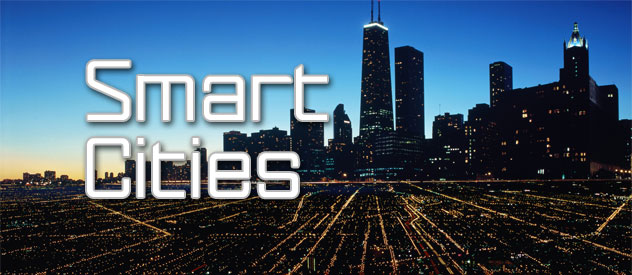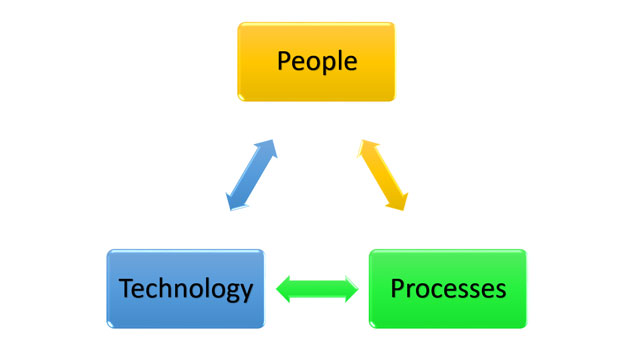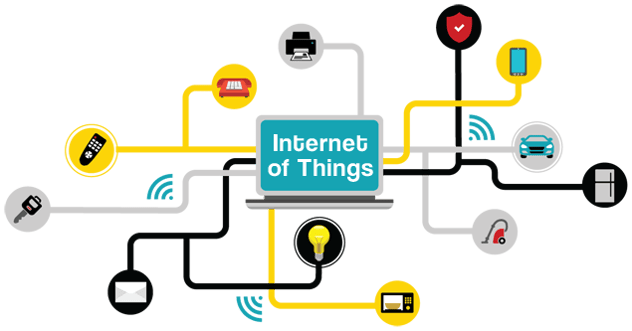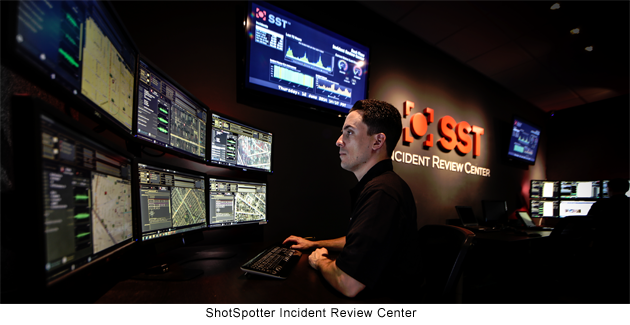
Municipal governments around the globe are employing big data and Internet-of-Things applications to improve many aspects of daily life. Major tech companies like IBM, Cisco and Microsoft are in on the trend, and are battling for a slice of the $15 billion that's projected to be spent on software by 2021, per Juniper Research.
Urban residents accounted for 54 percent of the total global population in 2014, according to the World Health Organization, and that figure was projected to grow nearly 2 percent each year until 2020. The growth signals increasing challenges that cities face to become “smarter” to better their residents. Whether it’s improving congested transportation systems or managing the data collected from the Internet-of-Things, smart cities are the providing a road map to a sustainable urban future around the world.
The Smart City Challenge
In December 2015, mid-sized American cities were asked to develop a transportation system which could help commute and movement of goods in a faster, cheaper and economic manner by using data, applications and technology. This was a part of the US Department of Transportation’s Smart City Challenge where came forward with their challenges and the ideas they had to tackle them. Seven ideas were picked and the winner, Columbus, Ohio, along with the other finalists worked on developing their ideas further in collaboration with the Department of Transportation.
$350 million in public and private funding has been leveraged since 2015 by the US Department of Transportation for smart city and high-end transportation technology. With the Beyond Traffic 2045 vision, the Smart City Challenge gave the nudge to cities that wanted to upscale their transportation system making people’s lives better.
 The Department also announced that the winning city of the Smart City Challenge would receive $40 million, which led to other cities leveraging another $500 million in private and public funds towards making the Smart City vision a reality. In October 2016, another $65 million in grants was announced by The Department for the four finalist cities to support advanced technology transportation projects that were community-driven.
The Department also announced that the winning city of the Smart City Challenge would receive $40 million, which led to other cities leveraging another $500 million in private and public funds towards making the Smart City vision a reality. In October 2016, another $65 million in grants was announced by The Department for the four finalist cities to support advanced technology transportation projects that were community-driven.
The Smart City Challenge inspired American cities through competition, collaboration and experimentation to use new technologies for their most daunting problems. The Challenge also went beyond technology, calling on mayors to define their most critical transportation problems and envision out-of-the-box solutions to revolutionize transportation so that the needs of all residents could be met, no matter their age or physical abilities. It aimed at creating a link in the digital divide so that even those who weren’t tech-savvy could make the best use of what was being offered.
The Definition of a Smart City
A smart city is vision for urban development which aims to manage the city’s assets like the local departments, supply networks, information systems, schools, libraries, law enforcements and hospitals. This is accomplished by safely integrating multiple information communication technology (ICT) and Internet of Things (IoT) so that there can be an improvement in the urban residents’ quality of life and the efficiency of services extended to them.
Sectors like government services, water, healthcare, energy, transportation innovative urban agriculture and waste management have been developing their own smart city technology and architecture. The need for these technologies are typically driven by the individual sector, but they often share a similar infrastructure.
The four defining factors of a smart city as given by Mark Deakin and Al Waer, authors of the book “From Intelligent to Smart Cities” are:
- Electronic and digital technologies being applied to cities and communities
- Transforming life and work environments using ICT
- Government systems embedded with ICT
- Practices bringing ICTs and people together being territorialized for the enhancement of innovation and the knowledge offered
A smart city also uses information technology for:
- Efficiently using physical infrastructure like roads, buildings and other physical assets to build a stronger and healthier socio-economic and cultural development by leveraging data analytics and artificial intelligence.
- Improving the collective intelligence of the city’s institutions by engaging with the locals involved in governance and decision making through open innovation processes and e-participation emphasizing citizen participation and co-design
- Responding promptly and effectively to changing circumstances by learning, adapting and innovating leading to improvement in the city’s intelligence.
There are 3 types of intelligence in smart cities:
- Orchestration intelligence: Bletchley Park in England, where Alan Turing’s team decoded the Nazi Enigma Cypher was the first example of a smart city. It was the definition of community-based problem solving and collaboration.
- Empowerment intelligence: Kista Science City in Stockholm, the Cyberport Zone in Hong Kong and similar facilities that exist in Melbourne, Australia are built on open platforms, experimental facilities and smart city infrastructure for cluster innovation.
- Instrumentation intelligence: The use of real-time data collection, analysis and predictive modelling for a smarter city infrastructure as was implemented in Amsterdam.

The three fundamentals for the success of an initiative for a smart city are People, Processes and Technology – PPT. Citizens, communities, business drivers and processes must be thoroughly integrated and clearly defined objectives must be created to meet the citizen’s needs. With clear objectives, technology can be applied for improving the quality of life and creation of real economic opportunities. A holistic tailored approach accounting for long-term city planning, cultures of the city and local regulations will help bring cohesion to the process.
Smart Grids
Technology that uses computer-based remote control and automation to utility electricity delivery systems is called a ‘smart grid’. Bilateral communication and enhanced computer processing used in other types of industries helps manage electricity networks, like power plants, wind mills and electricity for home and business infrastructures. This methodology has yielded major advancements in energy efficiency within the electricity grid and energy efficiency for homes and workplaces.
For over 100 years, utility companies would send their workers to manually gather the energy consumption data. They would also look for broken equipment, read meters and take voltage measurements among other tasks. Many of the devices that the utilities use for delivering electricity aren’t yet automated or computerized, but the electricity industry now has several options and products for its modernization.
We define a ‘smart phone’ these days as a phone which has a computer in it. Similarly, a smart grid indicates computerization of the electric utility grid. It meant the addition of a bilateral technology for digital communication to devices that related to the grid.
Sensors like those for voltage, power meters, and fault detectors for gathering data can be given to each device on the network. These sensors can also be combined with digital communication between the device which is in the field and the center for the operations of the utility’s network. Automation technology through which the utility can make adjustments and control each individual device or several other devices from a centralized location is a key feature of the smart grid.
With the deployment of data communication technology there is a wide range of applications that can be used on the smart grid and their use is growing rapidly. This approach offers better cyber-security, can handle sources of electricity like solar and wind power and can also serve for the integration of electric vehicles onto the grid. Tech giants, communication firms and even start-up technology firms are heavily invested in producing the next generation of smart grid technology.
The Internet of Things
Mechanical and digital machines, objects or people are provided with unique identifiers with the ability of transferring data over a network without any human intervention through a system of inter-related computing devices – thanks to the Internet of Things. Leaps in wireless technology and the standardization of communication protocols have made collection of data that the sensors offer a possibility, from any location at any time.
 New capabilities are being added to silicon chips that are becoming smaller and less expensive. Cloud computing is increasing the storage power which makes processing big data analytics possible on a massive scale and at low costs.
New capabilities are being added to silicon chips that are becoming smaller and less expensive. Cloud computing is increasing the storage power which makes processing big data analytics possible on a massive scale and at low costs.
With these technologies maturing, there is an increase in corporate deployment of the Internet of Things. There are six primary types of applications that are emerging and they can broadly be categorized into two categories: Information and its analysis and its applications in automation and control.
Information and Its Analysis
Better information is generated with powerful new networks that bridge the data generated from products, the operating environment or the assets of the company. These networks can lead to better analysis and hence better decision making. Organizations are beginning to implement these applications in specifically targeted areas.
Tracking behavior
Embedding products with sensors enables their tracking and monitoring of interactions. The behavioral data can be exploited for fine-tuning business models.
For example: insurance companies can deploy location sensors in the cars of customers so they can base the pricing of the policy on how well the car is driven and where it has travelled. This helps customization of the price to the actual risks involved in the operation of the vehicle instead of the traditional method that was based on factor such as driver’s gender, age or residential location.
A popular application of Internet of Things in the B2B marketplace is that which involves the use of sensors for the tracking of the RFID (radio frequency identification) tags that are installed on products which move along supply chains. This not only improves inventory management but also reduces the cost involved in the logistics and significantly reduces working capital.
Sensor technology is also spurring the business models of the aviation industry. Jet engine manufacturers can charge airlines vendors only for the amount of thrust that they have used and retain the ownership themselves. Airplanes with network sensors are being manufactured for facilitating the sending of data on product wear and tear to their computers in real-time, so that they can plan for continuous maintenance and reduce unplanned downtime.
Enhanced Awareness of Situations
A large number of sensors have been installed in infrastructure like buildings and roads. Data generated from these sensors can report environmental conditions like ocean currents or moisture content of the soil. This information can help with decision making by providing better awareness of events in real-time, especially when the sensors used have been equipped with advanced visualization technologies and displays.
Sensors combining audio/visual and vibration detectors can be very useful in assisting security personnel when spotting unauthorized individuals entering restricted areas. Traffic patterns, weather conditions and vehicle locations can be tracked by the logistics managers within trucking and airlines industries. This data can lead to improvement in traffic routing which can reduce the cost incurred due to congestion and increase the effective capacity of the network. Law-enforcement officers can also be able to obtain data instantly from sonic sensors that can exactly narrow down the location of a gunfire with tools such as ShotSpotter.

Decision Analytics Based on Sensors
Internet of Thingsrequires huge amounts of storage and resources for computing that can be linked with advanced software systems which have the ability for generating a wide variety of graphic displays for the analysis of data. It has provided support for longer-range and more complex human planning and decision making.
For example, the oil and natural gas industry can rely on a voluminous network of sensors that are installed in the earth’s crust for the next phase of their exploration and development. These sensors will be able to produce more factual readings of the structure, location and dimensions of potential fields which cannot be achieved with the current methods. This results in improved oil flows which come at a lower cost of development.
Retail businesses are exploring ways of gathering and processing data from shoppers in their brick and mortar stores. Sensor reading and videos are generating data on how long they wander around a single display and also record their final purchases. Retail layouts can be optimized on the basis of this data so that revenues can be increased.
Healthcare industries are using these data links and sensors for better monitoring of the behavior of patients and their real-time symptoms while at a lower cost. This allows physicians to improve their diagnosis of diseases so that customized treatment plans can be prescribed.
Sensors have been fitted for patients with chronic diseases in some healthcare trials to monitor their conditions continuously throughout their daily life. In trials with patients suffering from congestive heart failure, real-time data monitoring provided physicians with early warning signals for conditions which could lead to hospitalization and emergency care. This increase in efficiency not only cuts down treatment costs for patients but also helps in better management of the patients’ condition.
Control and Automation
With data becoming the ground for automation and control, it can be converted, analyzed and collected through the Internet of Thingsinto instructions that can be fed through the network right back to the actuators who can modify the processes. This flow of relevant information helps close the circuit between data and automated applications. It can also increase productivity exponentially because systems can now automatically adjust to situations that are complex, making human intervention unnecessary.
The implementation of these resources can offer immediate payoffs for early adopters of basic applications. As the technologies evolve further, organizations will continue to adopt these advanced automated systems or risk falling behind their more tech-savvy competitors.
Process Optimization
There are now new perimeters for process improvement thanks to the Internet of Things. Industries like those dealing with chemical production now experience greater granularity in monitoring with the installation of massive data collection sensor networks. The computers subsequently analyze this data and send signals to the actuators that adjust the process by making modifications to temperatures, pressures or ingredient mixtures.
Actuators and sensors have also been used for changing the alignment of a physical object moving along an assembly line, so that it reaches in an optimal position at the machine tools. This process optimization can prevent jams caused due to small inconsistencies in the position of the objects. Improvements in process management can produce major reductions in terms of energy costs, wastage and human intervention.
Optimized Consumption of Resources
Patterns in which scarce resources like energy and water are used have seen a huge improvement because of networked sensors and automated feedback that have enabled real-time dynamic pricing. Data centers are now adopting power-management techniques tied to information feedback, helping to improve global energy efficiency. Intelligent reductions in power consumption can save facilities almost half the total cost incurred in its lifetime.
Complex Systems That Are Autonomous
Real-time detection of unpredictable conditions coupled with instant response directed by automated systems is one of the most demanding challenges for the Internet of Things. The decision making of machines based on human reactions is now possible and at a heightened level of performance.
There are systems being developed by the automobile industry for detecting probable collisions. Many new cars are also using applications like automatic braking inspections which potentially reduce accidents, providing savings that could reach $100 billion annually.
 Autopilot technology for vehicles that are networked and can drive in a conforming manner at speeds of the highway is also a promising next generation technology. This type of capability could lead to a reduction in ‘phantom jams’ which occur due to small disturbances like sudden illumination of brake lights and possibly prevent traffic bottlenecks.
Autopilot technology for vehicles that are networked and can drive in a conforming manner at speeds of the highway is also a promising next generation technology. This type of capability could lead to a reduction in ‘phantom jams’ which occur due to small disturbances like sudden illumination of brake lights and possibly prevent traffic bottlenecks.
Networks of robots are being tested by scientists with the goal of maintaining facilities or cleaning up toxic waste. Systems that coordinate movements of unmanned aircrafts are also being studied for the defense industry.
The Internet of Things in Smart Cities
With smart devices and sharing platforms on the rise, it has become possible to generate more data about consumer preferences and daily habits. Listed below are some major initiatives pertaining to Internet of Things in cities:
- Water management: 15 billion gallons of water was lost per year in Houston due to leaky pipes. Intelligent pump control systems and sensors were embedded to tackle this problem and it lead to a better regulation of water-flow and identification of issues. Additional water management applications for smart cities include irrigation, quality of water, flooding, storm water runoff, and household water management.
- Conservation of Energy: A Real-Time Energy Management (RTEM) program where sensors are used along with big data analytics and smart meters for the optimization of energy in commercial buildings was developed by the New York State Energy Research and Development Authority (NYSERDA).
- Transportation: The city that won the US Department of Transportation’s Smart City Challenge – Columbus, Ohio deployed self-driving electric shuttles that can operate alongside a new rapid transit center. According to CompTIA, the system offers improved vehicle-to-vehicle data exchange and also fosters communication with traffic signals and other transportation infrastructure.
- Public Safety: Street lights have been replaced in Copenhagen, Denmark with smart LED lights that are energy-efficient. These can be auto-dimmed based on the time of the day or on a full moon day, using sensors and connectivity to the city’s network. The brightness can also be increased when they sense bikers or walkers. There are several other smart city projects for public safety like video surveillance systems that are equipped with advanced analytics, drones that can fight forest fires and report incidents as well as monitor systems for citizens.
- Environment: a network of ‘citizen observatories’ is being deployed by a consortium of 14 European Countries called the CITISENSE. These will monitor the quality of air through sensors that are wearable. Several similar approaches for crowdsourcing are being developed in Beijing and other cities.
The evolution of Smart Cities around the world is still in its infancy. Growing pains caused by the security concerns from an avalanche of new connected gadgets will be an ongoing issue. However, as technology continues to improve and the providers of this technology refine their processes, nearly every city around the world will need to take advantage of the benefits.


